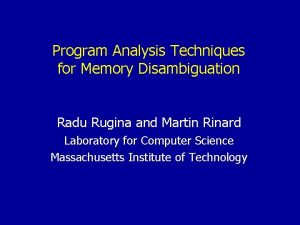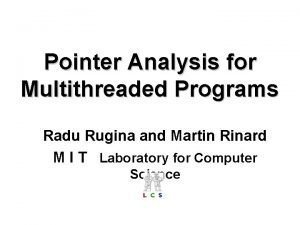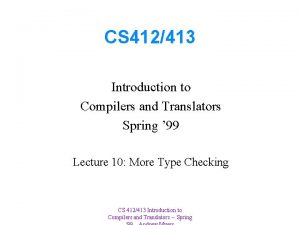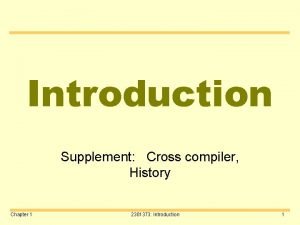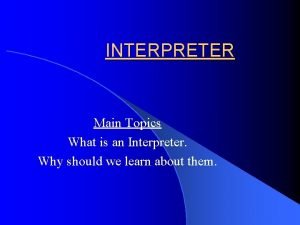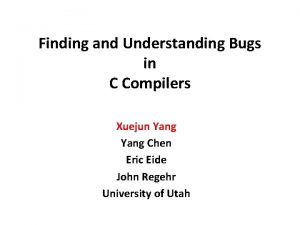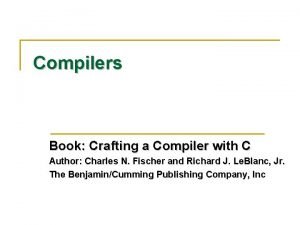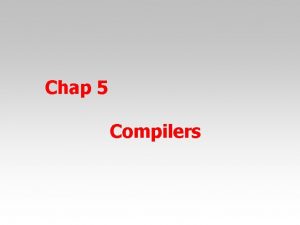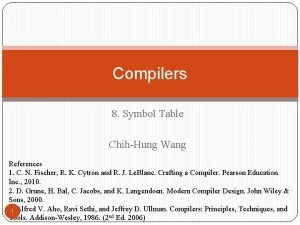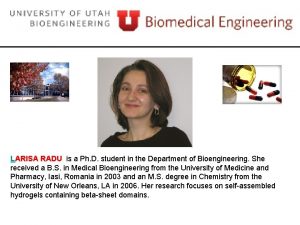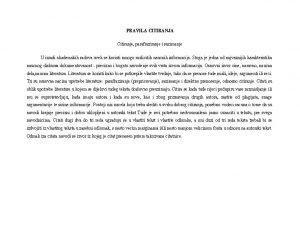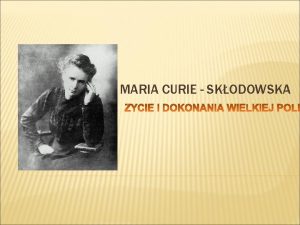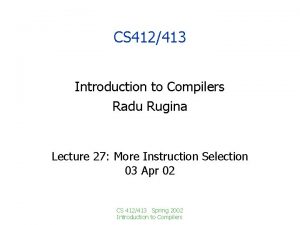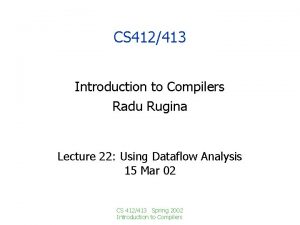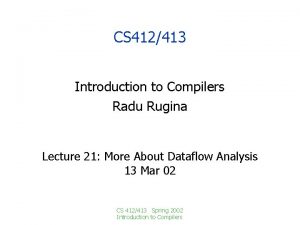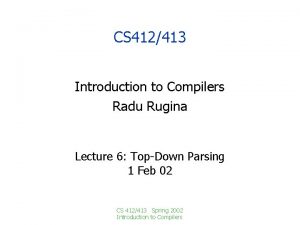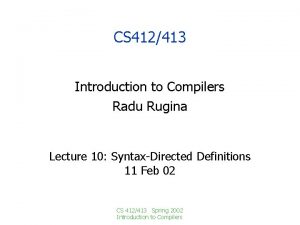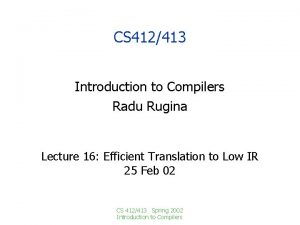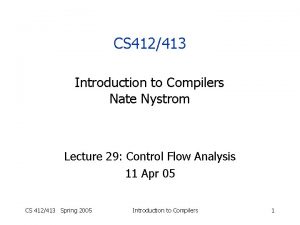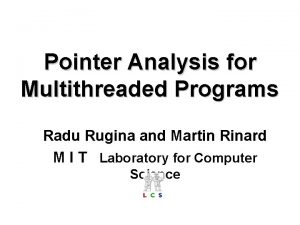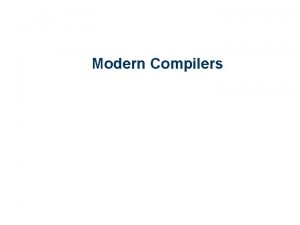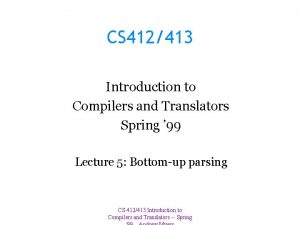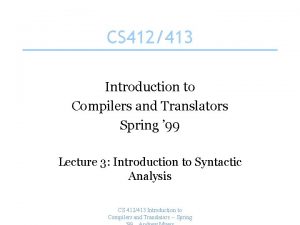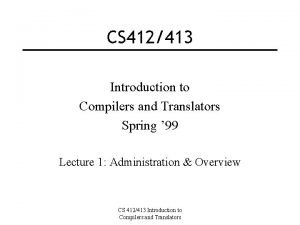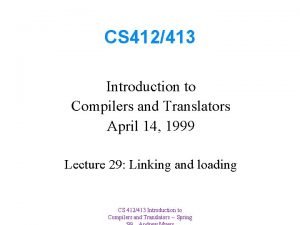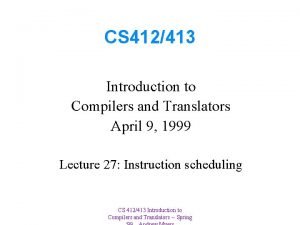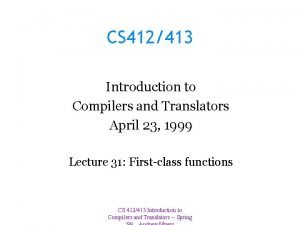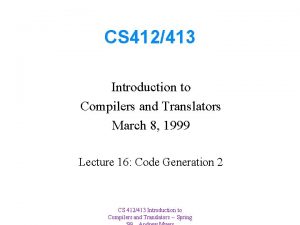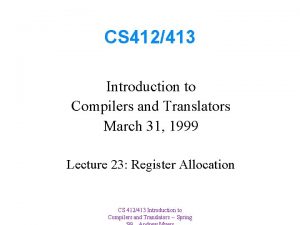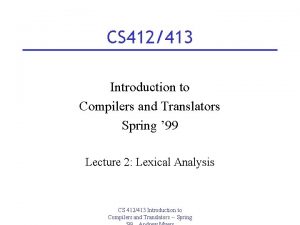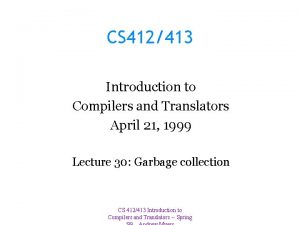CS 412413 Introduction to Compilers Radu Rugina Lecture



























- Slides: 27

CS 412/413 Introduction to Compilers Radu Rugina Lecture 5: Context-Free Grammars 30 Jan 02 CS 412/413 Spring 2002 Introduction to Compilers

Outline • JLex clarification • • Context-Free Grammars (CFGs) Derivations Parse trees and abstract syntax Ambiguous grammars CS 412/413 Spring 2002 Introduction to Compilers 2

JLex: Clarification • JLex tries to find the longest matching sequence • Problem: what if the lexer goes past a final state of a shorter token, but then doesn’t find any other longer matching token later? • Consider R = 00 | 10 | 0011 and input w = 0010 0 0 1 1 5 0 0 2 1 3 1 4 6 • We reach state 3 with no transition on input 0! • Solution: record the last accepting state CS 412/413 Spring 2002 Introduction to Compilers 3

Lexical Analysis • Translates the program (represented as a stream of characters) into a sequence of tokens • Uses regular expressions to specify tokens • Uses finite automata for the translation mechanism • Lexical analyzers are also referred to as lexers or scanners CS 412/413 Spring 2002 Introduction to Compilers 4

Where We Are Source code (character stream) if (b == 0) a = b; Lexical Analysis Token stream if ( b == 0 ) a = b ; Abstract Syntax Tree (AST) CS 412/413 Spring 2002 == b Syntax Analysis (Parsing) if 0 = a b Introduction to Compilers Semantic Analysis 5

Syntax Analysis Example { Source code (token stream) } Abstract Syntax Tree == block while_stmt if_stmt. . . variable constant b if (b == (0)) a = b; while (a != 1) { stdio. print(a); a = a - 1; } 0 != variable constant a 1 block expr_stmt. stdio call print = . . . variable a CS 412/413 Spring 2002 Introduction to Compilers 6

Parsing Analogy • Syntax analysis for natural languages: recognize whether a sentence is grammatically well-formed & identify the function of each component. “I gave him the book” sentence object subject: I verb: gave indirect object: him noun phrase article: the CS 412/413 Spring 2002 Introduction to Compilers noun: book 7

Syntax Analysis Overview • Goal: determine if the input token stream satisfies the syntax of the program • What we need for syntax analysis: – An expressive way to describe the syntax – An acceptor mechanism that determines if the input token stream satisfies that syntax description • For lexical analysis: – Regular expressions describe tokens – Finite automata = acceptors for regular expressions CS 412/413 Spring 2002 Introduction to Compilers 8

Why Not Regular Expressions? • Regular expressions can expressively describe tokens – easy to implement, efficient (using DFAs) • Why not use regular expressions (on tokens) to specify programming language syntax? • Reason: they don’t have enough power to express the syntax in programming languages • Example: nested constructs (blocks, expressions, statements) – Language of balanced parentheses {{}} {}{} {{ }{ {}} { {{}{{}{}}} – We need unbounded counting! CS 412/413 Spring 2002 { … } Introduction to Compilers } } } 9

Context-Free Grammars • Use Context-Free Grammars (CFG): – Terminal symbols = token or ε S a. Sa S T – Non-terminal symbols = syntactic variables T b. Tb – Start symbol S = special nonterminal T – Productions of the form LHS RHS • LHS = a single nonterminal • RHS = a string of terminals and non-terminals • Specify how non-terminals may be expanded • Language generated by a grammar = the set of strings of terminals derived from the start symbol by repeatedly applying the productions – L(G) denotes the language generated by grammar G CS 412/413 Spring 2002 Introduction to Compilers 10

Example • Grammar for balanced-parenthesis language: S {S}S S • 1 nonterminal: S • 2 terminals “{” and “}” • Start symbol: S • 2 productions: • If a grammar accepts a string, there is a derivation of that string using the productions: S = (S) = {{S} S} = {{ } } = {{}} CS 412/413 Spring 2002 Introduction to Compilers 11

Context-Free Grammars • Shorthand notation: vertical bar for multiple productions S a. Sa | T T b. Tb | • Context-free grammars = powerful enough to express the syntax in programming languages • Derivation = successive application of productions starting from S (the start symbol) • The acceptor mechanism = determine if there is a derivation for an input token stream CS 412/413 Spring 2002 Introduction to Compilers 12

Grammars and Acceptors • Acceptors for context-free grammars Context-Free G Grammar Token Stream Acceptor s Yes, if s L(G) No, if s L(G) • Syntax analyzers (parsers) = CFG acceptors which also output the corresponding derivation when the token stream is accepted – Various kinds: LL(k), LR(k), SLR, LALR CS 412/413 Spring 2002 Introduction to Compilers 13

RE is Subset of CFG • Inductively build a grammar for each regular expression ε S ε a S a R 1 R 2 S S 1 S 2 R 1 | R 2 S S 1 | S 2 R 1 * S S 1 S | ε where: G 1 = grammar for R 1, with start symbol S 1 G 2 = grammar for R 2, with start symbol S 2 CS 412/413 Spring 2002 Introduction to Compilers 14

Sum Grammar • Grammar: S E+S | E E number | ( S ) • Expanded: S E+S S E E number E (S) 4 productions 2 non-terminals (S, E) 4 terminals: (, ), +, number start symbol S • Example accepted input: (1 + 2 + (3+4)) + 5 CS 412/413 Spring 2002 Introduction to Compilers 15

Derivation Example S E+S|E E number | ( S ) Derive (1+2+ (3+4))+5: S E + S ( S ) + S (E + S )+ S (1 + S)+S (1 + E + S)+S (1 + 2 + E)+S (1 + 2 + ( S ) )+S (1 + 2 + ( E + S ) )+S (1 + 2 + ( 3 + E ) )+S (1 + 2+ (3+4))+S replacement string (1 + 2+ (3+4))+E non-terminal being expanded (1 + 2+ (3+4))+5 CS 412/413 Spring 2002 Introduction to Compilers 16

Constructing a Derivation • Start from S (start symbol) • Use productions to derive a sequence of tokens from the start symbol • For arbitrary strings , and for a production A a single step of derivation is: A (i. e. , substitute for an occurrence of A) • Example: S E+S (S + E) + E (E + S + E)+E CS 412/413 Spring 2002 Introduction to Compilers 17

Derivation Parse Tree S E + S Parse Tree ( S) E E+ S 5 1 E+S 2 E (S) E+S E 3 4 Derivation • Parse Tree = tree representation of the derivation • Leaves of tree are terminals • Internal nodes: non-terminals • No information about order of derivation steps S E + S ( S ) + S (E + S ) + S (1 + S)+S (1 + E + S) + S … (1 + 2 + ( S ) ) + S (1 + 2 + ( E + S ) )+S … (1 + 2 + ( 3 + E))+S … (1 + 2+ (3+4))+5 CS 412/413 Spring 2002 Introduction to Compilers 18

Parse Tree vs. AST • Parse tree also called “concrete syntax” S E + S Parse Tree ( S ) E (Concrete E + S 5 Syntax) 1 E+S 2 E (S) E+S E 3 4 CS 412/413 Spring 2002 Abstract Syntax Tree + + 1 5 + + 2 3 4 Discards (abstracts) unneeded information Introduction to Compilers 19

Derivation order • Can choose to apply productions in any order; select any non-terminal A: A • Two standard orders: left- and right-most -- useful for different kinds of automatic parsing • Leftmost derivation: In the string, find the left-most non -terminal and apply a production to it E+S 1+S • Rightmost derivation: find right-most non-terminal…etc. E+S E+E+S CS 412/413 Spring 2002 Introduction to Compilers 20

Example • S E+S|E E number | ( S ) • Left-most derivation S E+S (S) + S (E + S )+ S (1 + S)+S (1+E+S)+S (1+2+E)+S (1+2+(S))+S (1+2+(E+S))+S (1+2+(3+E))+S (1+2+(3+4))+E (1+2+(3+4))+5 • Right-most derivation S E+E E+5 (S)+5 (E+E+S)+5 (E+E+E)+5 (E+E+(S))+5 (E+E+(E+E))+5 (E+E+(E+4))+5 (E+E+(3+4))+5 (E+2+(3+4))+5 (1+2+(3+4))+5 • Same parse tree: same productions chosen, diff. order CS 412/413 Spring 2002 Introduction to Compilers 21

Ambiguous Grammars • In example grammar, left-most and right-most derivations produced identical parse trees • + operator associates to right in parse tree regardless of derivation order + + (1+2+(3+4))+5 1 5 + + 2 3 CS 412/413 Spring 2002 Introduction to Compilers 4 22

An Ambiguous Grammar • + associates to right because of right-recursive production S E+S • Consider another grammar: S S + S | S * S | number • Ambiguous grammar = different derivations produce different parse trees CS 412/413 Spring 2002 Introduction to Compilers 23

Differing Parse Trees S S + S | S * S | number • Consider expression 1 + 2 * 3 • Derivation 1: S S + S 1 + S * S 1+2*S 1+2*3 • Derivation 2: S S * 3 S + S * 3 S+2*3 1+2*3 + 1 2 CS 412/413 Spring 2002 * 3 + 1 * 2 Introduction to Compilers 3 24

Impact of Ambiguity • Different parse trees correspond to different evaluations! • Meaning of program not defined + 1 2 * CS 412/413 Spring 2002 3 =7 + 1 * 2 Introduction to Compilers 3 =9 25

Eliminating Ambiguity • Often can eliminate ambiguity by adding nonterminals & allowing recursion only on right or left S S+T | T T T * num | num S S+T T T*3 1 2 • T non-terminal enforces precedence • Left-recursion : left-associativity CS 412/413 Spring 2002 Introduction to Compilers 26

CFGs • Context-free grammars allow concise syntax specification of programming languages • CFGs specifies how to convert token stream to parse tree (if unambiguous!) • Read Appel 3. 1, 3. 2 CS 412/413 Spring 2002 Introduction to Compilers 27
 Radu rugina
Radu rugina Radu rugina
Radu rugina Static semantics
Static semantics Anghel rugina
Anghel rugina Cs 421
Cs 421 Binarymove compilers
Binarymove compilers Cross compilers
Cross compilers What is an interpreter
What is an interpreter Finding and understanding bugs in c compilers
Finding and understanding bugs in c compilers Crafting a compiler with c
Crafting a compiler with c Function of compiler
Function of compiler Back end
Back end Lex leblanc
Lex leblanc Interpreter in compiler construction
Interpreter in compiler construction Cs 421 programming languages and compilers
Cs 421 programming languages and compilers 01:640:244 lecture notes - lecture 15: plat, idah, farad
01:640:244 lecture notes - lecture 15: plat, idah, farad Seminarski prva strana
Seminarski prva strana Radu mariescu istodor
Radu mariescu istodor Viitor cu cap de mort
Viitor cu cap de mort Zavrni
Zavrni Larisa radu
Larisa radu Komentar zakona o radu
Komentar zakona o radu Radu meza
Radu meza Parafraziranje aplikacija
Parafraziranje aplikacija Seminarski rad primjer word
Seminarski rad primjer word Seminarski rad literatura primer
Seminarski rad literatura primer Pravila citiranja
Pravila citiranja Skodowska
Skodowska
